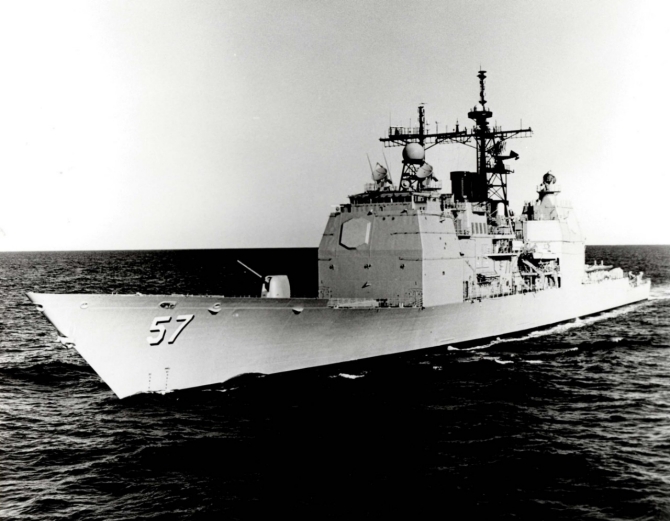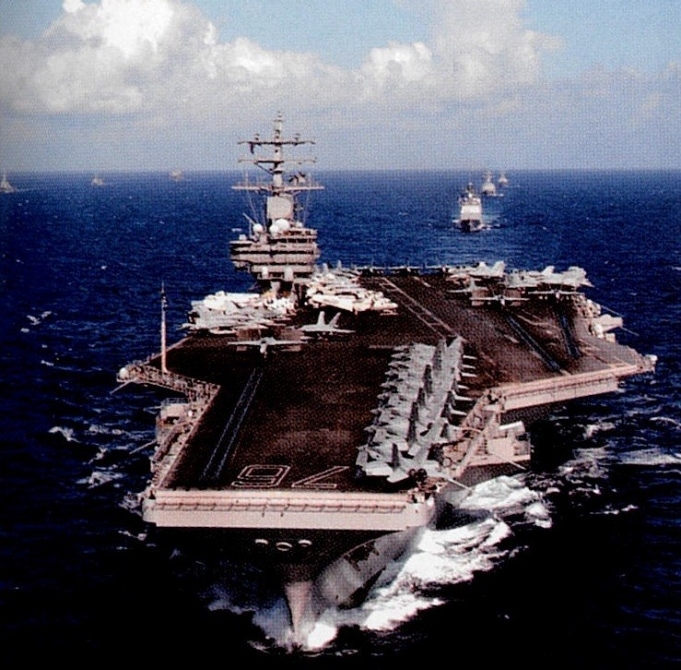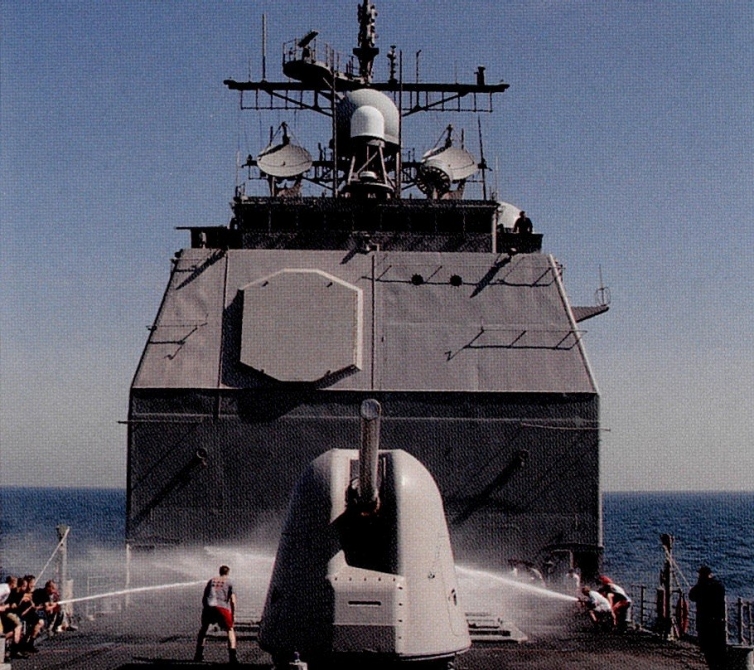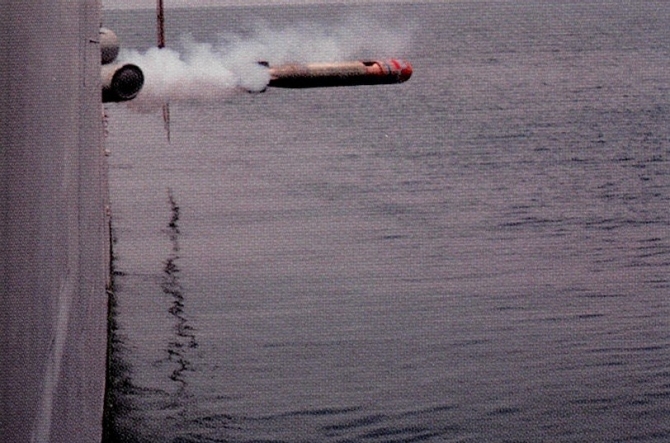Lake Champlain III (CG-57)
1988-2023
A lake in the State of New York where Commodore Thomas McDonough defeated a larger and more heavily armed British squadron on 11 September 1814.
The first Lake Champlain, a steamer, served from 1918-1920. The second Lake Champlain (CV-39), an aircraft carrier, served from 1945-1966.
III
(CG-57: displacement 9,600; length 567'; beam 55'; draft 33'; speed 30+ knots; complement 363; armament 2 5-inch, 2 Mk 41 Vertical Launch Systems (VLS) for BGM-109 Tomahawks, RIM-66 SM-2MR Standards, and RUM-139 VL-ASROC Antisubmarine Rockets, 8 RGM-84 Harpoon anti-ship missile canister launchers, 2 Mk 15 Close In Weapon Systems (CIWS), 4 .50 caliber machine guns, and 6 Mk 32 torpedo tubes, aircraft 2 Sikorsky SH-60B Light Airborne Multi-Purpose System (LAMPS) Mk III Seahawks; class Ticonderoga)
The third Lake Champlain (CG-57) was laid down on 3 March 1986 at Pascagoula, Miss., by Ingalls Shipbuilding Division, Litton Industries; launched on 3 April 1987; sponsored by Mrs. Susan E. Pyatt, wife of Everett A. Pyatt, Assistant Secretary of the Navy, Shipbuilding and Logistics; and commissioned without ceremony on 12 August 1988 at New York City, Capt. Ralph K. Martin in command.

Lake Champlain shifted from the Atlantic Fleet to the Pacific Fleet (15 August-8 October 1988). She rendezvoused with aircraft carrier Independence (CV-62) on 16 August and anchored at St. Thomas, Virgin Islands (20-23 August). King Neptune arrived on board Lake Champlain for the first time when she crossed the equator at 43°42'2"W on 14 September. “As the king and his homely queen held court,” the cruiser’s historian reported, “the embarked shellbacks ensured that the ship’s pollywogs were duly initiated into the solemn mysteries and ancient order of the deep. The pollywogs, having been examined by Neptunus Rex and found acceptable, became shellbacks.” Lake Champlain then visited Rio de Janeiro, Brazil (3-6 September), but suffered a major lube oil leak in Main Engine Room No. 1 on 11 September. The engineering team contained the leak without reporting crew casualties and the ship continued her voyage, only to lose her hurricane bulwark while battling heavy seas two days later. The cruiser reached her lowest point of latitude when she rounded Cape Horn at 56°6'S at 1435 on 14 September. Lake Champlain detached from Independence on 21 September, and the following day operated with Peruvian frigates Mariátegui (F.54), Montero (F.53), and Villavicencio (F.52), and attack submarine Casma (SS.31), before removing the damaged sections of the bulwark and installing temporary stanchions while visiting Lima, Peru (23-25 September). Lake Champlain crossed the equator at 85°2'3"W on 27 September. She rejoined Independence while anchored at Acapulco, Mexico (1-4 October), and moored temporarily at Naval Air Station (NAS) North Island and then at her new home port of Naval Station (NS) San Diego, Calif., on 8 October.
An SH-60B Seahawk of Helicopter Antisubmarine Squadron Light (HSL) 45 Detachment 10 and Kaman SH-2F Seasprites of HSLs 33 Detachment 3 and 35 Detachment 1, embarked altogether on board Lake Champlain, frigates Lockwood (FF-1064) and Stein (FF-1065), and tanker Navasota (T-AO-106), rescued 19 crewmembers from Chinese merchant vessel Huazhu when she sank 40 miles off northern Luzon, Philippines, on 25 January 1990. On 26 June 1990, Lake Champlain, operating within the Pacific Missile Test Center’s sea test range in Californian waters, accomplished the first ship launch of an AGM-84 Standoff Land Attack Missile from a Harpoon canister. A LAMPS Mk III helicopter controlled the launch and down linked video images to the ship’s command information center via the Seahawk’s Walleye data link pod.
Mount Pinatubo, a volcano located on Luzon in the Philippines, erupted on 12 June 1991. The mountain’s fury blackened the skies across Angeles City and much of Luzon for nearly 36 hours. Typhoon Yunya added to the devastation when it slammed inland with fierce winds and rain. The rain eventually cleared the atmosphere of most of the choking and blinding ash, but the disaster deposited a heavy eight-inch coating of grey ash over much of the area around NS Subic Bay and NAS Cubi Point. Sailors observed that the residue gave the landscape the appearance of dry cement. The ash crushed many lightweight structures, and a chalky film covered the bay, which presented the appearance of a translucent shade of green. The disaster cut electricity and water to the base for two days, and only heavy trucks could grind their way through the morass to reach victims. Rescue workers also contended with earthquake aftershocks. The volcanic eruption and the typhoon killed more than 300 people and displaced more than 300,000 victims.
Aircraft carriers Abraham Lincoln (CVN-72) and Midway (CV-41), together with ships from Amphibious Readiness Group Alpha, led by amphibious assault ship Peleliu (LHA-5), participated in Operation Fiery Vigil, the evacuation of victims. Abraham Lincoln transported 4,323 people, primarily USN and USAF dependents, from Subic Bay, Cubi Point, and Clark Air Base to Cebu City, Cebu, for further evacuation to Guam and the continental U.S.
Lake Champlain moored outboard of guided missile cruiser Long Beach (CGN-9) at Subic Bay on 17 June, the ship’s historian noting that the devastation and the suffering of the victims “overwhelmed” her crewmen. Within two hours the 304 people, primarily women and children, together with many of their pets and baggage, boarded the cruiser and squeezed into the after berthing compartments. The ship then sailed for Cebu, racing against the clock to come about for the remaining people trapped by the disaster, and the possibility of additional volcanic eruptions. Lake Champlain steamed 425 miles between the Philippine Islands at an average of speed of 30 knots and reached Cebu at 1400 the following day. The city did not have facilities capable of mooring a ship the size of the cruiser, however, so landing craft from Amphibious Readiness Group Alpha shuttled the evacuees to the airport by 1930. Lake Champlain weighed anchor and sped back to Subic Bay, refueling from oiler Hassayampa (T-AO-145) en route, and embarking another 302 people in the late afternoon. She came about and made at high speed for Cebu, dropping anchor in Magellan Bay on 20 June. The ship disembarked her passengers and made her third voyage, saving another 238 people. Lake Champlain evacuated a total of 844 people and their pets and steamed 2,500 miles during her three voyages of mercy. Thousands of Filipino looters magnified the tragedy when they climbed over the gates and ransacked abandoned homes. The mob swamped the gates, overwhelming military policemen by sheer numbers and determination.



An SH-60B of HSL-45 Detachment 4 flying from Lake Champlain spotted a skiff in distress in the Gulf of Aden on 23 May 2009. The Seahawk directed the ship to the area, which rescued 52 people who had been adrift in the vessel for seven days.
Detailed history under construction.
Mark L. Evans
2 September 2014


